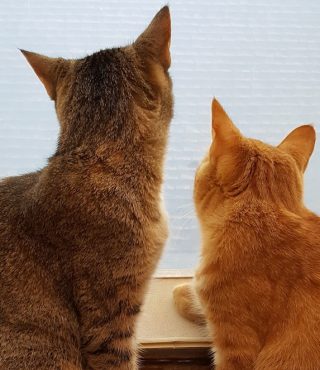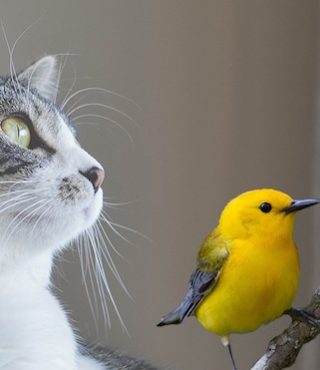Keeping Birds Safe at your Feeder

The Canadian Wildlife Health Co-operative has published a new technical report, “Strategies to Prevent and Control Bird-Feeder Associated Diseases and Threats.” The report was prompted by the widespread trichomonosis outbreak in 2017 that extended from Ontario east to Newfoundland and Labrador. This and other bird-feeder associated diseases and threats generate a lot of public concern, so the CWHC released this report to ensure the availability of accurate information on how to reduce the risks.
Feeding of wildlife is generally discouraged as part of the overall effort to reduce human-wildlife contact, conflicts, and disease transmission. But bird feeding is considered an exception to that rule, partly due to the fact birds don’t become dependent on feeders. (Instead, birds tend to incorporate them into a ‘route’ that combines feeders and natural sources.) The removal of any particular feeder along their route thus doesn’t have the same impact as it might with wildlife who become dependent on a particular food source.
Even so, as the popularity of bird-feeding increases, with millions of households providing huge quantities of supplementary food to wild birds, it has become increasingly important to ensure that people are aware of best-practices to reduce the potential harm of their bird feeders, primarily from diseases and predators.
Recommendations
- Avoid the unintended consequences of feeding that result from predation or trauma.
- Bird-feeders need to keep an eye on the birds at their feeders and be able to recognize signs of disease to ensure prompt implementation of disease control strategies.
- Create circumstances that lead to reduced contact between uninfected and infected birds and/or contaminated environments by:
- Promoting management for bird friendly habitat to avoid the need for supplemental feed to attract or nourish birds.
- Ensuring proper feeding techniques and hygienic feeding practices.
Best Practices
Placement
- Bird feeders should not be further than 3.5 meters from cover that provides a route of escape and protection to avoid predation.
- There should be an unobstructed view around bird feeders so that foraging birds can detect any predators in the area.
- Cover that could conceal predators attempting to mount an attack should not be near feeders.
- Feeders at lower levels should be surrounded by brush or fencing to preclude predator access.
- Bird feeders should be placed less than one meter or more than 10 meters away from buildings to minimize the risk of window collisions.
Food and Feeder Selection and Maintenance
- Use the right feeders the right way. Good bird feeders are made from plastic, steel or glass (because they’re easier to clean than wood or clay). Small feeders are best because they don’t allow large numbers of birds to congregate, reducing contact rates, and they empty quickly, which prevents seeds from getting wet or spoiled. Feeders should have drainage holes to prevent water accumulating, and they should not have sharp points or edges that may cause injury. They should be covered to prevent seed from getting wet, and they should allow birds to perch away from the food to prevent fecal contamination. (That latter is also why simply spreading food on the ground is not a good idea.) Always wear gloves and wash hands thoroughly after cleaning your feeders.
- Feed the right food. Provide only high-quality bird seed by reading the ingredients on the packages because bargain brands often contain “filler” seeds such as milo, red millet, ax, oats, rice and wheat that are generally not eaten by birds and will readily absorb moisture promoting spoilage and fungal growth. Additionally, these “filler” seeds are often discarded by birds beneath the feeders, attracting rodents and other non-target wildlife species. Different bird species prefer different seed types so take this into consideration when selecting bird food and provide a variety. Sunflower seeds are the top choice among most birds. Suet is great, but only in the winter months, since it goes rancid quickly in the heat. Safflower seeds, nyjer seeds and peanuts are other good choices that will attract a variety of species. Foods that have no nutritional value for birds or should not be fed to them include bread (especially if it is moldy because the bread mold fungus Aspergillus fumigatus is infectious for birds) and chocolate, which is toxic to birds.
- Clean bird feeders and artificial water sources regularly: both should be cleaned and disinfected twice a month while in use. Use a scrub brush and hot soapy water to clean debris and bird feces off the feeders. Special attention should be given to the perches and openings where the birds have to place their heads inside to get access to the bird feed. After cleaning, they should be disinfected by immersion for two to three minutes in a solution of one part of liquid chlorine bleach and nine parts of warm water, then rinsed with clean water and allowed to air dry.
- Remove feeders if an outbreak is detected, and consult your CWHC Regional Centre to find out when the danger has passed.
And:
- Use visual markers or other means to make your windows visible to birds. Learn more here.
- Keep domestic cats indoors or outdoors only on a leash or in an enclosure to prevent predation. Learn more here.
- Surveil the birds at your feeders: this is an important aspect of disease prevention in particular, since the possibility of outbreaks is a constant threat. As well as keeping an eye on your backyard birds, listen for alerts from press outlets and management agencies on disease outbreaks.
Download a copy of this article, or for more information on the signs and symptoms of some of the more common diseases, download a full copy of the CWHC report.








